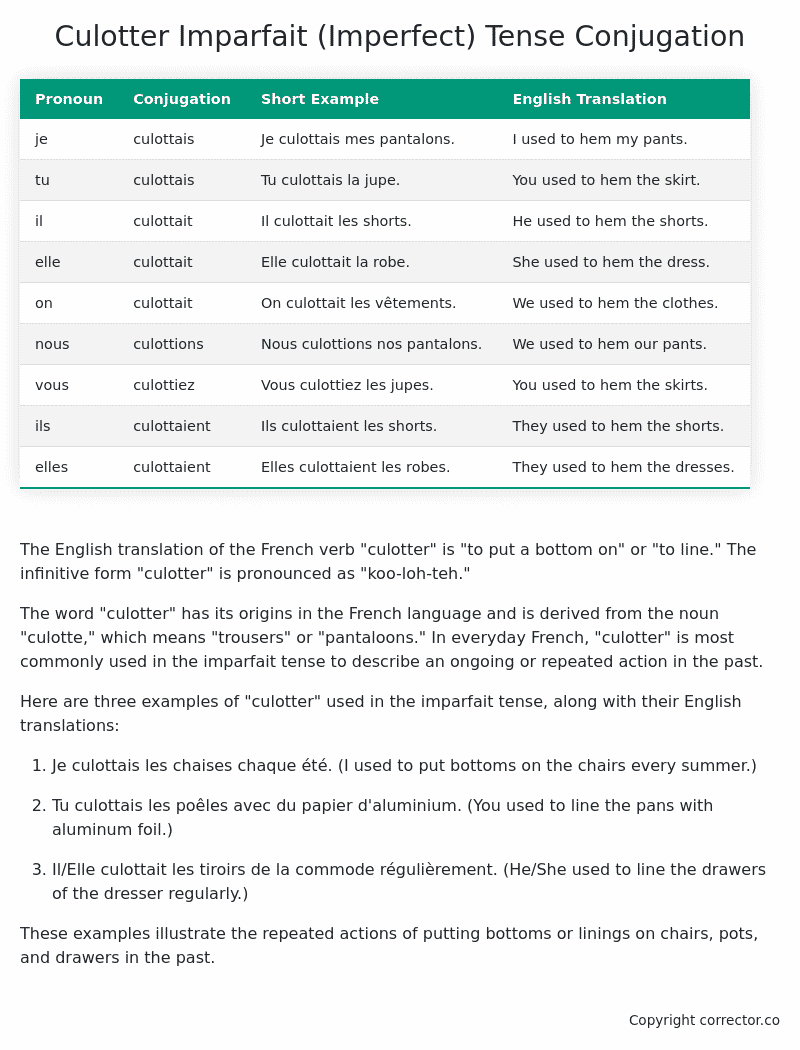Imparfait (Imperfect) Tense Conjugation of the French Verb culotter
Introduction to the verb culotter
The English translation of the French verb “culotter” is “to put a bottom on” or “to line.” The infinitive form “culotter” is pronounced as “koo-loh-teh.”
The word “culotter” has its origins in the French language and is derived from the noun “culotte,” which means “trousers” or “pantaloons.” In everyday French, “culotter” is most commonly used in the imparfait tense to describe an ongoing or repeated action in the past.
Here are three examples of “culotter” used in the imparfait tense, along with their English translations:
-
Je culottais les chaises chaque été.
(I used to put bottoms on the chairs every summer.) -
Tu culottais les poêles avec du papier d’aluminium.
(You used to line the pans with aluminum foil.) -
Il/Elle culottait les tiroirs de la commode régulièrement.
(He/She used to line the drawers of the dresser regularly.)
These examples illustrate the repeated actions of putting bottoms or linings on chairs, pots, and drawers in the past.
Table of the Imparfait (Imperfect) Tense Conjugation of culotter
| Pronoun | Conjugation | Short Example | English Translation |
|---|---|---|---|
| je | culottais | Je culottais mes pantalons. | I used to hem my pants. |
| tu | culottais | Tu culottais la jupe. | You used to hem the skirt. |
| il | culottait | Il culottait les shorts. | He used to hem the shorts. |
| elle | culottait | Elle culottait la robe. | She used to hem the dress. |
| on | culottait | On culottait les vêtements. | We used to hem the clothes. |
| nous | culottions | Nous culottions nos pantalons. | We used to hem our pants. |
| vous | culottiez | Vous culottiez les jupes. | You used to hem the skirts. |
| ils | culottaient | Ils culottaient les shorts. | They used to hem the shorts. |
| elles | culottaient | Elles culottaient les robes. | They used to hem the dresses. |
Other Conjugations for Culotter.
Le Present (Present Tense) Conjugation of the French Verb culotter
Imparfait (Imperfect) Tense Conjugation of the French Verb culotter (You’re reading it right now!)
Passé Simple (Simple Past) Tense Conjugation of the French Verb culotter
Passé Composé (Present Perfect) Tense Conjugation of the French Verb culotter
Futur Simple (Simple Future) Tense Conjugation of the French Verb culotter
Futur Proche (Near Future) Tense Conjugation of the French Verb culotter
Plus-que-parfait (Pluperfect) Tense Conjugation of the French Verb culotter
Passé Antérieur (Past Anterior) Tense Conjugation of the French Verb culotter
Futur Antérieur (Future Anterior) Tense Conjugation of the French Verb culotter
Subjonctif Présent (Subjunctive Present) Tense Conjugation of the French Verb culotter
Subjonctif Passé (Subjunctive Past) Tense Conjugation of the French Verb culotter
Subjonctif Imparfait (Subjunctive Imperfect) Tense Conjugation of the French Verb culotter
Subjonctif Plus-que-parfait (Subjunctive Pluperfect) Tense Conjugation of the French Verb culotter
Conditionnel Présent (Conditional Present) Tense Conjugation of the French Verb culotter
Conditionnel Passé (Conditional Past) Tense Conjugation of the French Verb culotter
Conditionnel Passé II (Conditional Past II) Tense Conjugation of the French Verb culotter
L’impératif Présent (Imperative Present) Tense Conjugation of the French Verb culotter
L’impératif Passé (Imperative Past) Tense Conjugation of the French Verb culotter
L’infinitif Présent (Infinitive Present) Tense Conjugation of the French Verb culotter
L’infinitif Passé (Infinitive Past) Tense Conjugation of the French Verb culotter
Le Participe Présent (Present Participle) Tense Conjugation of the French Verb culotter
Le Participe Passé (Past Participle) Tense Conjugation of the French Verb culotter
Struggling with French verbs or the language in general? Why not use our free French Grammar Checker – no registration required!
Get a FREE Download Study Sheet of this Conjugation 🔥
Simply right click the image below, click “save image” and get your free reference for the culotter imparfait tense conjugation!

Culotter – About the French Imparfait Tense
NOTE: To take a deep dive into all the French tenses then see our article on Mastering French Tense Conjugation.
Formation of the Imparfait Tense
For regular -er verbs:
For regular -ir verbs
For regular -re verbs
Common Everyday Usage Patterns
Description of Past Habits
Background Information
Mental and Emotional States
It’s employed to express emotions, thoughts, or physical sensations in the past. For example: “J’étais content quand il est arrivé.” (I was happy when he arrived.)
Ongoing Actions
Points to Note About the Imparfait Tense
Passé Composé vs. Imparfait
Conditional
Si Clauses
Narration
I hope you enjoyed this article on the verb culotter. Still in a learning mood? Check out another TOTALLY random French verb imparfait conjugation!


